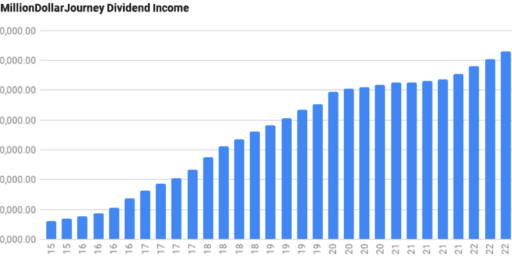Net Worth Update Feb 2012 (+1.91%) – Market Gains Edition
Welcome to the Million Dollar Journey February 2012 Net Worth Update. For those of you new to Million Dollar Journey, a monthly net worth update is typically posted near the end of the month (or beginning of the next) to track the progress of my journey to one million in net worth, hopefully by the time I’m 35 years old (end of 2014). If you would like to follow my journey, you can get my updates sent directly to your email or you can sign up for the Money Tips Newsletter..
In the last net worth update, we had a discussion about additional assets to include in the net worth update. I agree with most of the readers that RESP‘s should not be included because the intention of the money is for helping our kids with their tuition bills. Since we have two young kids, they are both on the family RESP plan anyways, so if even if one doesn’t attend post secondary, it’s likely that the other will.
Another thought was including the after tax value of our corporate investment account. We haven’t setup the investment account yet as I’m waiting to move retained corporate cash over to a holding corp. Once I setup the account, I’ll include the after tax value of the new portfolio.
With that aside, lets move onto this months net worth update. The big news is the stock market which has done most of the heavy lifting in the net worth gain this month. Notable organic growth includes RRSP (+2.06%) and the leveraged Canadian dividend stocks portfolio (+2.59%).
You may notice that the non-registered account has grown almost 15% in one month, but that not completely organic. The good part is that half the gain is from my high risk trades with options, the other half of the gain is from moving money into the account. I have some capital losses from previous years to claim against the capital gains, but if these gains keep up, I will be recording them as a tax liability.
All in all, a good couple months to start the year, and a psychological breakthrough to the $600,000’s.
On to the numbers:
Assets: $691,480 (+1.71%)
- Cash: $4,500 (+0.00%)
- Savings: $58,000 (+3.45%)
- Registered/Retirement Investment Accounts (RRSP): $123,900(+2.06%)
- Tax Free Savings Accounts (TFSA): $40,500 (+0.75%)
- Defined Benefit Pension: $37,900 (+0.80%)
- Non-Registered Investment Accounts: $33,180 (+14.49%)
- Smith Manoeuvre Investment Account: $91,000 (+2.59%)
- Principal Residence: $300,500 (+0.00%) (purchase price adjusted for inflation annually)
Liabilities: $82,200 (+0.24%)
- Principal Residence Mortgage (readvanceable): $0 (0.00%) (Paid off in 2010!)
- Investment LOC balance: $82,200 (+0.24%)
Total Net Worth: ~$609,280 (+1.91%)
- Started 2011 with Net Worth: $585,228
- Year to Date Gain/Loss: +4.11%
Some quick notes and explanations to net worth questions I get often:
The Cash
The $4,500 cash are held in chequing accounts to meet the minimum balance so that we pay no fees (accounting for regular bill payments – ie. our credit card bill). Yes, we do hold no fee accounts also, but I find value in having an account with a full service bank as the relationship with a banker has proven useful.
Savings
Our savings accounts are held with PC Financial and ING Direct. We usually hold a fair bit of cash in case “something” comes up. The “something” can be anything that requires cash such as an investment opportunity that requires quick cash or maybe an emergency car/home repair. We also need cash to cover any future tax liabilities.
Real Estate
Our real estate holdings consist of a primary residence and REITs plus a rental property. The value of the principal residence remains valued at the purchase price (+inflation) despite significant appreciation in the local real estate market.
Pension
The pension amount listed above is the value of both of our defined benefit pension plans. I basically take the semi annual statement and add the contribution amounts (not including employer matching) on a monthly basis. The commuted value of the pensions are not included in the statements as they are difficult to estimate.
Stock Broker Accounts
Another common question is which discount broker do I use? We actually have accounts with multiple institutions. I’m hoping to reduce the number of accounts that we hold in the near future. Here is a review of some of the more popular online stock brokers.
I've Completed My Million Dollar Journey. Let Me Guide You Through Yours!
Sign up below to get a copy of our free eBook: Can I Retire Yet?










@Ray, even though margin rates are attractive, I’d rather not have the possibility of a margin call.
Since the mortgage is paid off should you still call the Smith Manoeuvre Investment Account as is or call it a plain old leverage account? I’m in a similar postion as you with leveraging but do you have any thoughts on going with a margin account vs. heloc? Assuming the borrowing rates are the same i.e. 3%. I ask because there’s still a lien on the paid off home and would rather use the leveraged securities as the “collateral” instead of the home.
@Daniel, ya you are probably close in valuation, but after legal and realtor fees,it’s probably closer to $400k. I’d rather be conservative with the home valuation as home values can fluctuate, especially in an aggressive market like St. John’s.
Think it’s time to update the value of your house? Given the market I wouldn’t doubt your house is worth $450,000.
Yes – I am a Newfie as well so I am all too aware of the escalating prices.
However, maybe for dramatic effect you can get your house appraised in December 2014 to boost you over the $1 million mark if you haven’t already made it.
RG,
Care Vest Corp is not publicly traded. How can somebody obtain shares, and more important, how can we sell them if needed?
Thanks
Alex
@FrugalTrader – Dividends can be paid at any point in time during the year, provided that the appropriate corporate law matters are met (generally a dividend resolution signed by the directors, and meeting the solvency requirement under corporate law, so that creditors are not disadvantaged). If paying an eligible dividend, you must provide written notification to the recipient of the dividend at the time of payment that the dividend is an eligible dividend. This can be done through a notation on the cheque stub, or if all of the shareholders are also directors, in the dividend resolution. It is important to note that this written notification is not required in the case of a “regular” dividend.
Any taxable dividends paid by the company to a shareholder must be reported on a T5, and filed with the CRA by the end of February.
It’s also worth noting that with a private company, you can only pay eligible dividends if you have GRIP (General Rate Income Pool) available at the end of the year. Any eligible dividends received get added to GRIP dollar for dollar. Therefore, assuming you have received a $100 dividend from a public company in your holding company, you could pay $100 as an eligible dividend as you would have sufficient GRIP. If you pay eligible dividends in excess of your GRIP at year end, there is a penalty tax which can be assessed.
Thanks for the detailed response Tax CA. Can the eligible dividends be paid out annually out of the holding corporation? Or does it matter? As well, how does the company report the payment on a T5? Is it simply counted as an eligible dividend distribution?
@FrugalTrader – I think that the overall before / after tax aspect is more important for consistency. For example – investment gains inherently have a future tax liability associated with them. Same with RRSP and holding company investment balances. The question is, fundamentally, whether a future tax component should be recognized in personal statements of net worth?
Under accounting standards, corporations reflect future tax liabilities in their financial statements – although those will not always capture the full extent of them, depending on the underlying accounting policies. In a personal net worth context – most people would quote a “gross” number and ignore the future tax liabilities, so I would suggest that using “gross” numbers would be appropriate for comparability. If someone had purchased stock for $1 and it was now worth $1,000 – they would likely say the stock was worth $1,000 – not “$1,000 less a future tax liability.” Food for thought… but I’d suggest keeping it off for broader comparability. That being said, the most important aspect is personal consistency… so your call!
For dividends – I can confirm that eligible dividends essentially flow through (although it depends on the province). A $100 eligible dividend will attract a $33 refundable Part IV tax, which is refunded at the rate of $1 for every $3 of taxable dividends paid. Therefore, the $100 from a public company (eligible dividend), will attract $33 of tax in the company. When a $100 dividend is paid (as an eligible dividend), the company will receive the $33 back, and the shareholder will pay tax. In Ontario, at the top marginal rate, that is 29.54%. To follow it through – the shareholder would pay apx $30 in tax (in this example). Therefore, if the dividend was not paid out of the company in the same year, there is a prepayment of $3 of tax.
The exact nature of the “flow through” and deferral or prepayment of tax will depend on the province and the shareholder’s marginal tax rate.
@Tax CA, point taken about the after tax reporting on the hold corp. With regards to RRSP tax liability, what would you use as the average tax rate for a net worth liability?
Also with regards to dividends withing a holding corp, other accountants have confirmed for me that eligible dividends can flow through (effectively no tax for the corp) to shareholders, and taxed in the shareholders hands and eligible for the div tax credit. Can you confirm this?
@Saveddijon – Investment income (not dividends) in a holding company is taxed at apx 50% – depending on the province. However, of that 50%, just over half (26.67% of the total) is a refundable tax. That tax is refundable when a taxable dividend is paid at the rate of $1 for every $3 of taxable dividends which are paid.
Therefore, the refundable tax is really just a prepaid tax – one that assumes that the recipient of the dividend is in the top marginal bracket. If the income was earned in the company and paid out to an individual right away (one who is in a lower bracket) – the effective tax rate is reduced on the investment income.
The biggest advantage with a holding company is that you can invest after corporate tax funds, as opposed to after personal tax fund. Consider someone with a tax rate of 40% who wants to invest $100. They would need to earn $166 to have $100 left over to invest. In contrast, if that income was earned through a company (which qualified for the small business deduction) – only apx 15% corporate tax would need to be paid. Therefore, to invest that same $100 – the business would only need to earn $117. The additional tax (i.e. the personal tax layer) is deferred until the money is withdrawn from the company via a dividend.
The rates will vary from province to province, but serve to illustrate the concept.